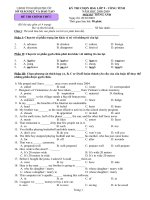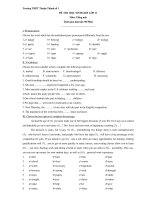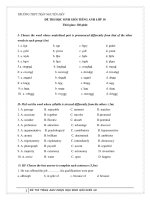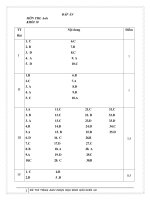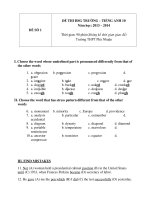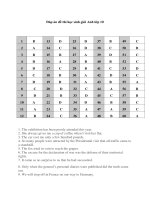ĐỀ THI HỌC SINH GIỎI VÒNG TRƯỜNG MÔN TIẾNG ANH - TRƯỜNG THPT ĐẦM DƠI ppsx
Bạn đang xem bản rút gọn của tài liệu. Xem và tải ngay bản đầy đủ của tài liệu tại đây (135.83 KB, 7 trang )
1
SỞ GIÁO DỤC VÀ ĐÀO TẠO ĐỀ THI HỌC SINH GIỎI VÒNG TRƯỜNG
TRƯỜNG THPT ĐẦM DƠI MÔN TIẾNG ANH
THỜI GIAN: 180 PHÚT
I. Chose the best answer from A,B,C or D (2m)
1. The judge…………the pedestrian for the accident.
A. accused B. charged C. blamed D. sued
2. Helen asked me……….the film called “Star Wars”
A. Have I seen B. have you seen C. if I had seen D. if had I seen
3. Firemen rescued several people from……….floor of the blazing building.
A. high B. top C. basement D. low
4. The main road through Salisbury was blocked for 2 hours today after an accident……….several
vehicles.
A. containing B. connecting C. involving D. including
5. The police are……… the town for the missing vehicle.
A. seeking B. looking C. investigating D. combing
6. The government’s present policy is seen as a………to local democracy.
A. threat B. harm C. suppression D. sneer
7. He told his father a long and……… story to explain his lateness.
A. inconceivable B. unconvincing C. unimaginable D. incredulous
8. A part-time job gives me the freedom to………my own interests.
A. pursue B. chase C. seek D. catch
9. In some parts of the world the indigenous population has been completely…………
A. wiped up B. wiped out C. wiped away D. wiped off
10. After Mervyn’s accident and his subsequent appearance in court, he was………….from
driving for a year.
A. dispossessed B. forfeited C. disqualified D. invalidated.
11. The examiner will test your……… to drive under normal conditions.
A. ability B. advantage C. wisdom D. virtue
12. A learner driver must be………by a qualified driver.
A. connected B. accompanied C. involved D. associated
13. The house was burgled while the family was………in a card game.
A. entertained B. buried C. busy D. absorbed
14. Switzerland is well-known for its impressive mountainous…………
A. views B. scenes C. scenery D. sights
15. His speech was careful and…………. but his words seemed to make no sense.
A. distinguished B. distinct C. distinctive D. distinguishable
16. Learners of English as a foreign language often fail to ……… between unfamiliar sounds in
that language.
A. separate B. differ C. distinguish D. solve
17. After a long and exhausting journey, they arrived home……………
A. finally B. by the end C. at the end D. at last
18. Sport provides an……… for a teenager’s feeling aggression or frustration.
A. overflow B. exist C. outlet D. exhaust
19. A relief……….has been set up to help earthquake victims.
A. fund B. donation C. treasury D. collection
20. The purpose of the survey was to…… the inspectors with local conditions.
A. inform B. acquaint C. instruct D. notify
II. Give the correct form of the word (2m)
1. He felt very………when he saw he had failed the exam again. (COURAGE)
2. He promised to come but he’s very…………. ( RELY)
3. She is extremely………… about the history of art. (KNOW)
4. It’s very …………….to live in a damp room. (HEALTH)
5. She felt a sense of… when her friend went to live abroad. (LOSE)
6. Most birds………in winter. (MIGRATORY)
7. He was too……….to tell his teacher about the stupid mistake. (SHAME)
2
8. The police are interested in the sudden………of the valuable painting. (APPEAR)
9. She divorced him because of his………to the children. (KIND)
10. The thing I hate about John is his………………. (RELIABLE)
11. Burning coal is an…… way of heating a house. Gas is much cheaper. (ECONOMY)
12. The old fishing village is very………. ( PICTURE)
13. This matter is very……… Don’t discuss it outside the office. (CONFIDENCE)
14. Ants and bees are described as …….insects. (INDUSTRY)
15. Uncle Ho is well-known for his…………… ( MODEST)
16. The………of energy has increased steadily. (CONSUME)
17. …, it had been raining all day, so we had to postpone the match. (FORTUNE)
18. The villagers have ……… mostly maize and beans (CULTIVATION)
19. Cheap consumer goods are……………in the part of the world. (ABUNDANCE)
20. I’ve been one of the……… of this journal for more than ten years. (SUBSCRIBE)
III. Fill each blank with a suitable word (2m)
When they get……(1)………, most animals move about and search for food. They fly, crawl,
swim, hop, walk or run. Some animals are……(2)……to move about and therefore must wait for
food to come to them. If an animal……(3)… get food, it will die.
Most plants cannot move about to search for food. They cannot fly, crawl, swim, walk or run.
Their…(4)……hold them firmly in the soil. Yet they are……(5)…… to keep growing and seem to
have plenty of food.
For a long time people believed that plants…(6)……only soil for food. A…(7 )…thoughtful
people noticed that plants …(8)… grew in pots did not seem to use up the soil. No matter
(9)…large such plants became, the amount of the soil in the pots remained about
the…(10)…….This was very puzzling.
At last a man thought of an experiment to find out (11)….plants use soil for food. He placed
a pot of soil in the oven. He heated it until the water was driven off and the soil was very
……(12)… Then he weighed the pot of soil very carefully and wrote down its
exact…(13)…….Next he…(14)……some seeds in the soil, and gave them plenty of water. When
the seeds had … (15)… into large plants, he removed these plants, roots and all …(16)…the pot. He
…(17)…the pot of soil again and weighed it. It weighed only a very little less than it…(18)…….
before. The plants had gained a great…(19)….in weight, but the soil had …(20)….only a very little
in weight.
IV. Sentence transformation (2m)
1. After fighting the fire for 12 hours the firemen succeeded in putting it out.
The firemen managed…………………………………………………………………………………………
2. Henry regretted buying the second hand car.
Henry wished………………………………………………………………………………………………….
3. The only reason the party was a success was that a famous film star attended.
Had it not been……………………………………………………………………………………………….
4. Although Judy was severely disabled, she participated in many sports.
Despite her…………………………………………………………………………………………………….
5. The patient recovered more rapidly than expected.
The patient made……………………………………………………………………………………………
6. He was suspended for two matches for swearing at the referee.
Swearing at the referee earned…………………………………………………………………………….
7. The students’ riotous behavior should have been severely punished.
The students deserved ………………………………………………………………………………………
8. It was wrong of you to scare your brother like that.
You shouldn’t………………………………………………………………………………………………….
9. Jenny and Kate grew up happily.
Jenny and Kate had…………………………………………………………………………………………
10. Jack spends all his time working.
Jack is………………………………………………………………………………………………………….
11. Caral finds it easy to make friends.
Caral has no………………………………………………………………………………………………….
3
12. Garrulous people annoy her.
Garrulous people get………………………………………………………………………………………
13. It was Walter Raleigh who introduced potatoes and tobacco into England.
The English owe……………………………………………………………………………………………
14. It was his incompetence which led to their capture.
If it……………………………………………………………………………………………………………….
15. They were just as good as we had expected.
They certainly lived……………………………………………………………………………………………
16. The Pacific Ocean is on average deeper than the Atlantic.
The average……………………………………………………………………………………………………
17. Most of the students ignored what the teacher was saying.
Few……………………………………………………………………………………………………………
18. The film star wore dark glasses so that no one could recognize her.
The film star avoided………………………………………………………………………………………
19. Customs officials are stopping more travelers than usual this week.
An increased………………………………………………………………………………………………….
20. I dislike it when people criticize me unfairly.
I object…………………………………………………………………………………………………………
V. Choose the incorrect part and correct it (2m)
1. Today’s farmers have increased milk production greatly through improved methods of
A B C
breeding, feeding, and manage dairy cattle.
D
2. Hypoglycemia is a condition in which a rapidly drop in blood sugar most often results from
A B C
an oversecretion of insulin from the pancreas.
D
3. Newborn infants show a distinct preference for human voices over other sounds and also
A B
prefer her own mothers’ voices to the voices of stranger.
C D
4. The Chippewa and Santee Sioux of the Upper Mississippi River regional have used catlinite
A B
to produce carvings for almost 150 years.
C D
5. Absolutely nothing that floats, neither a cocked bottle nor a 50,000-ton ships can escape the
A B C D
effects of water currents.
6. The Wright Brothers were owner of a bicycle shop, and they used a number of bicycle parts
A B
to make the original motorized airplane.
C D
7. Gemstones are usually bright, color, opaque or transparent minerals found in the rocks of
A B C D
the Earth
8. The modern detective story, in which a detective solves a crime by discovering and
A B
interpretation evidence is considered to have originated with Edgar Allan Poe’s “The murders in
C D
the Rue Morgue” in 1841.
9. The superintendent of women nurse for the Union Army during the Civil war was Dorothea
A B C D
Dix.
10. Slow growth in the early 1900’s, linked with rising unemployment, less spend, and meager
A B C
4
business investments, led many experts to declare a recession.
D
11. Orchestrating musical works requires a understanding of the range and characteristics of
A B C
each instrument.
D
12. The Canadian province of British Columbia is rich of minerals and, because over 50 percent
A
of the land is covered with forests, lumbering is its major industry.
B C D
13. Each major styles of architecture emerged because new problems in building or challenges
A B
in design appeared for architects to resolve.
C D
14. Much of the significant research related for the theory of numbers concerns the distribution
A B C D
of prime numbers.
15. Lauren Bacall made her film debut in To Have and Have Not, starring together Humphrey
A B C
Bogart, who later became her husband.
D
16. The black leopard is very dark that its spots are difficult to see.
A B C D
17. On steep hillsides, tree roots bind to soil that might otherwise be washed away if heavy
A B C D
rains
18. Carson McCullers was only 23 when she published for her first novel, The Heart Is A
A B
Lonely Hunter, for what she received much acclaim.
C D
19. Through the process of imprinting, the young of a species rapidly learn to recognize and
A B
follow other members of own species.
C D
20. The invention of fresh metaphors today continues to make it possible the vivid expression of
A B C D
emotions.
21. Proteins are made up of long, folded irregularly chains, the links of which are amino acids.
A B C D
22. Although most species of small birds gather in groups at feeders provided by bird-watchers,
A
the bright red cardinals usually appears alone or with its mate.
B C D
23. The astronomy is the oldest science, but it continues to be at the forefront of scientific
A B C D
thought.
24. Henry David Thoreau was an American writer who is remembered for his faith in religious
A B C
significance of the nature.
D
25. Gold or silver bullion serve into commerce as mediums of exchange all over the world.
A B C D
5
VI. Reading comprehension
Question 1-10
Before mid-1960’s, the impact of the railroads in the United States was limited, in the sense that
the tracks ended at the Missouri River, approximately the center of the country. At that point the
trains turned their freight, mail, and passengers over to steamboats, wagons, and stagecoaches. This
meant that wagon freighting, stagecoaching, and steamboating did not come to an end when the first
train appeard; rather they become supplements or feeders. Each new “end-of-task” became a center
for animal- drawn or waterborne transportation. The major effect of the railroad was to shorten the
distance that had to be covered by the older, slower, and more costly means. Wagon freighters
continued operating throughout the 1870’s and 1880’s and into the 1890’s, although over constantly
shrinking routes, and coaches and wagons continued to crisscross the West wherever the rails had
not yet been laid.
The beginning of a major change was foreshadowed in the late 1860’s, when the Union Pacific
Railroad at last began to build westward from the Central plains city of Omaha to meet the Central
Pacific Railroad advancing eastward from California through the formidable barrier of the Sierra
Nevada. Although the president Abraham Lincoln signed the original Pacific railroad bill in 1862
and revised, financially much more generous version in 1864, little construction was completed until
1865m on the Central Pacific and 1866 on the Union Pacific. The primary reason was skepticism
that a railroad built through so challenging and thinly settled a stretch of desert, mountain, and
semiarid plain could pay a profit. In the words of an economist, this was a case of “premature
enterprise”, where not only the cost of construction but also the very high risk deterred private
investment. In discussing the Pacific Railroad bill, the chair of the congressional committee bluntly
stated that without government subsidy no one would undertake so unpromising a venture: yet it
was a national necessity to link East and West together.
1. The author refers to the impact of railroads before the late 1860s as “ limited” because
A. the tracks did not take the direct route from one city to the next
B. passengers and freight had to transfer to other modes of transportation to reach western
destinations
C. passengers preferred stagecoaches
D. railroad travel was quite expensive
2. The word “they” in line 5 refers to
A. tracks
B. trains
C. freight, mail, and passengers
D. Steamboats, wagons, and stagecoaches
3. The word “supplements” in line 5 refers to
A. extensions
B. reformers
C. dependents
D. influences
4. What can be inferred about coaches and wagon freighters as the railroads expanded?
A. They developed competing routes
B. Their drivers refused to work for the railroads.
C. They began to specialize in transporting goods.
D. They were not used as much as before.
5. The word “crisscross” in line 9 is closet in meaning to
A. Lead the railway
B. Separate
C. Move back and forth
D. uncover
6. Why does the author mention the Sierra Nevada in line 14?
A. to argue that a more direct route to the West could have been taken
B. to identify a historically significant mountain range in the West.
C. to point out the location of a serious train accident
D. to give an example of an obstacle faced by the Central Pacific
5
10
15
20
6
7. The word “skepticism” in line 17 is closest in meaning to
A. doubt
B. amazement
C. urgency
D. determination
8. The Pacific rail roads were considered a “premature enterprise” (line 19) because
A. The technology of railroad cars was not fully developed
B. There was not enough wood and steel for the tracks
C. The cost and risks discouraged private investment
D. There were insufficient number of train people to operate then.
9. The word “subsidy” in line 21 is closet in meaning to
A. Persuasion
B. Finalizing
C. Explanation
D. Penalty
Question 10-20
Humanity’s primal efforts to systematize the concepts of size, shape, and number are usually
regarded as the earliest mathematics. However, the concept of number and the counting process
developed so long before the time of recorded history ( there is archaeological evidence that
counting was employed by humans as far as 50, 000 years ago) that the manner of this development
is largely conjectural. Imagining how it probably came about is not difficult. The argument that
humans, even in prehistoric times, had some number sense, at least to the extent of recognizing the
concepts of more and less when some objects were added to or taken away from a small group,
seems fair, for studies have shown that some animals possess such a sense.
With the gradual evolution of society, simple counting became imperative. A tribe had to know
how many members it had and how many enemies, a shepherd needed to know if the flock of sheep
was decreasing in size. Probably the earliest way of keeping a count was by some simple tally
method, employing the principle of one-to-one correspondence. In keeping a count of sheep, for
example, one finger per sheep could be turned under. Counts could also be maintained by making
scratches in the dirt or on a stone, by cutting notches in a piece of wood, or by typing knots in a
string.
Then, perhaps later, an assortment of vocal sounds was developed as a word tally against the
number of objects in a small group. And still later, with the refinement of writing, a set of signs was
devised to stand for these numbers. Such an imagined development is supported by reports of
anthropologists in their studies of present-day societies that are thought to be similar to those of
early humans.
10. What does the passage mainly discuss?
A. Their efforts of early humans to care for herds of animals
B. The development of writing
C. The beginnings of mathematics
D. Similarities in the number sense between humans and animals
11. The word “conjectural” in line 5 is closest in meaning to
A. Complex
B. Based on guessing
C. Unbelievable
D. Supported by careful research
12. Why does the author mention animals in line 8?
A. To support a theory about the behavior of early humans
B. To identify activities that are distinctly human
C. To illustrate the limits of a historical record of human development
D. To establish that early humans kept domesticated animals
5
10
15
7
13. The word “it” in line 10 refers to
A. Evolution
B. Counting
C. Tribe
D. Shepherd
14. What is the basic principle of the tally method described in the second paragraph?
A. The count is recorded permanently.
B. Calculations provide the total count.
C. Large quantizes are represented by symbols.
D. Each marker represents a single object.
15. The word “ employing” in line 12 is closet in meaning to
A. using
B. paying
C. focusing
D. hiring
16. Which of the following is NOT mentioned as an early method of counting?
A. cutting notches
B. bending fingers
C. piling stones
D. typing not
17. The word “maintained” in line 14 is closet in meaning to
A. justified
B. asserted
C. located
D. kept
18. The word “assortment” in line 16 closet in meaning to
A. instrument
B. variety
C. surplus
D. symbol
19. It can be inferred that research in other academic fields relates to research in the
author’s fields in which of the following ways?
A. It contributes relevant information
B. It is carried out on a simpler level.
C. It is less reliable than research in the author’s field.
D. It causes misunderstanding if applied to the author’s field.
20. Which of the following conclusions is supported by the passage?
A. Counting processes did not develop until after writing become widespread.
B. Early counting methods required herds of animals.
C. Mathematics has remained unchanged since ancient times.
D. Early humans first counted because of necessity.
THE END!


